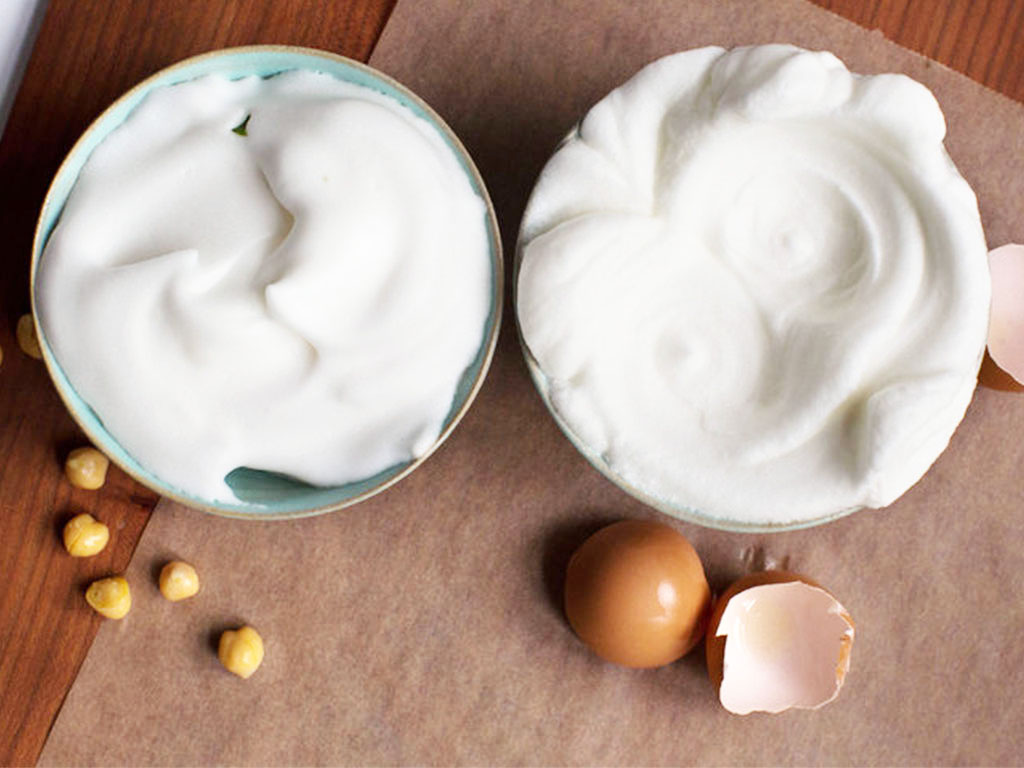4 Mins Read
Any vegan cook worth their salt will have war stories when it comes to vegan baking: replacing eggs is no easy feat. Sure there’s apple sauce and flax seeds, but let’s face it, they are hardly ideal solutions. Turns out, there’s a miracle vegan egg replacer that’s been right under our noses this whole time. You know the water that you throw out after you’re done with canned chickpeas? That liquid is vegan gold. Known in vegan foodie circles as aquafaba (latin for water + bean), this miraculous liquid is now seriously trending online. So what’s all the fuss about ‘bean water’?
Making meringues or macarons may seem like an impossibility for a vegan. Thanks to the magical powers of aquafaba, you can dream about desserts again. The liquid resembles the consistency of raw egg whites both beaten or unbeaten. Incredibly, aquafaba forms firm peaks when whisked. Scientists and biochemists are not totally certain about why this super-ingredient can do what it can do, though some surmise that it is a result of the proteins and dissolved starches it contains.
To bake or make desserts with aquafaba, you need to begin by ensuring that the liquid you get from the can has the consistency of egg whites. If it’s too runny, thicken it by boiling it for 5-10 minutes on the stove and then let it cool down. Once you get the right consistency, whisk it using a stand mixer or an immersion blender at high speed, until you are able to form firm peaks. Then follows with the most important part: adding sugar. For those avoiding sugar, tough luck. The powers of aquafaba require sugar to unlock them. The amount of sugar added can vary with the consistency of your aquafaba, but it usually ranges from a 1:2 ratio of aquafaba to sugar up to 2:1, according to the Official Aquafaba Website (yes, there is such a thing). In terms of what sugar to use, most bloggers are reporting that cheap white sugar offers the best results. That being said, results are possible with coconut flower sugar.
Since the discovery of aquafaba, a flurry of recipes have appeared all over the interwebs, recipes like vegan mayonnaise, fluffy vegan pancakes and vegan meringue. Even vegan macarons. Below we share our favourite aquafaba recipes from around the blogosphere so you can try aquafaba at home!
1. Strawberry Swirl Ice cream
People usually make vegan ice cream using frozen bananas or coconut milk to obtain that familiar creaminess. Aquafaba now offers you a third option that provides a dose of extra fluffiness in your ice cream! This strawberry swirl ice cream only requires five ingredients and while it does take longer than whipping up some banana ice cream, it’s definitely worth the wait! It’s also great for those who are not banana fans. Unlike the long yellow fruit, aquafaba is a relatively neutral-tasting ingredient.
2. Vegan French Toast
There are a fair few vegan French toast recipes out there that make use of egg replacers like chia seeds or flaxseeds for the batter. We’ve tried them. Unfortunately, they are nothing close to the real thing made with eggs and butter. So we thought we should give this recipe a go: all you need is only some aquafaba, non-dairy milk, sugar and vanilla extract (and bread of course!).
3. Vegan Mayonnaise
Did you think aquafaba is reserved for making sweet treats? Far from it! This vegan mayonnaise recipe utilizes this magical liquid to wonders. Sure, vegan mayo is nothing new in the plant-based community. But the existing ones tend to be heavy on the soy or cashews and they can feel quite heavy. Thanks to bean water, you can achieve that gorgeous mayonnaise creaminess with the lightness of the original.
4. Simple Meringue
Just aquafaba and sugar: whip them up and bake them. You will end up with these dreamy little meringues, the likes of which you were resigned to have given up forever. Yup, this one’s kinda life-changing.
5. Vegan Raspberry Rose Macaroons
If you think that vegans can’t have macaroons, think again. Crazy Vegan Kitchen blogger Amrita started making macaroons when she was 14 years old but until recently, it had never occured to her to make a vegan version. Schooled at Cordon Bleu, she used to sell her macarons for tea parties. After becoming a vegan, she assumed she had given up macaroons forever. Until she came across aquafaba. And voila: a vegan macaroon recipe that the chef claims taste 95% identical to the real thing!
Image courtesy: Meredith Heuer for The New York Times (lead photo), Tina from Banana Bloom, Vegan Mother Hubbard, Leanne Kitchen and Amrita from Crazy Vegan Kitchen









